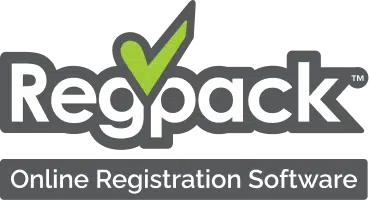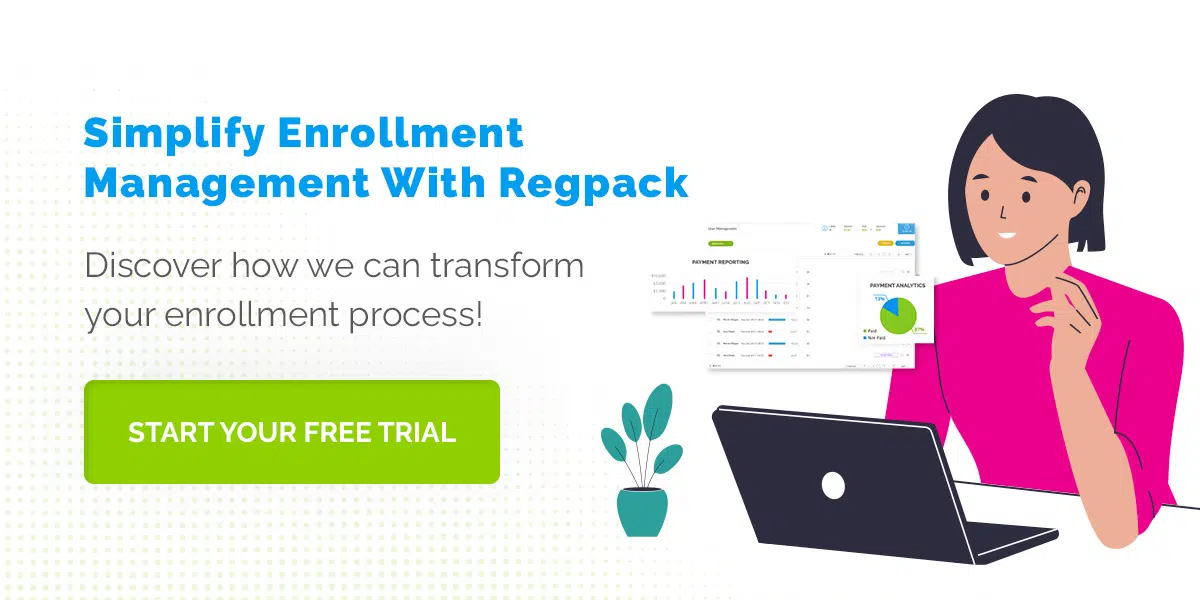From camps and courses to workshops, trips, and specialized programs, many organizations rely on enrollment revenue to succeed. Whether you manage seasonal registrations or year-round participation, you need effective solutions to grow.
If your business depends on enrollment, this guide is for you. We’ll explain the principles, tools, and strategies that can help you streamline your process, boost engagement, and build a more resilient framework.
- A Beginner’s View of Enrollment Management
- Why Is Effectively Managing Enrollment Important?
- Key Areas of Enrollment Management
- Roles and Responsibilities in Enrollment Management
- Organizational Models for Enrollment Management
- How to Successfully Manage Enrollment
- How Does Enrollment Management Software Work?
- Simplify Enrollment Management With Regpack
A Beginner’s View of Enrollment Management
Enrollment management principles apply to any organization that manages participants, such as online learning platforms, summer camps, or professional training programs. Enrollment covers the entire time a person spends in a program, from recruitment to completion.
For example, enrollment management for higher education typically involves long-term planning across multiple departments. These plans often span several years and include specific goals, timelines, and actionable strategies to meet institutional objectives. However, it also encompasses businesses that organize summer camps for children or companies that offer courses.
In short, if your business relies on attracting, recruiting, and retaining people, the benefits of enrollment management go beyond organization.
Why Is Effectively Managing Enrollment Important?
When you enroll people in your course, school, or camp, the resulting revenue directly impacts your bottom line. Many organizations depend on enrollment numbers to remain sustainable. Future programs may be at risk if registrations fall short of the target.
Enrollment is also a pass-fail factor for many higher education institutions. According to the National Center for Education Statistics, tuition and fees are constantly rising. Those institutions’ annual per-student revenue has steadily increased in the last 35 years. As the stakes rise, so does the need for strategy — ensuring recruitment, retention, and student success align with long-term financial goals.
The data collected throughout the enrollment process can reveal participant behavior, preferences, and engagement. Whether you manage a university program, STEM camp, or online course, this information helps you tailor offerings, enhance the participant experience, and strengthen your market position. That clarity can lead to stronger retention, increased revenue, and more impactful programming over time.
Key Areas of Enrollment Management
Generally, there are four distinct enrollment management categories.
- Admission management: This area deals with applications, registrations, admissions, and other aspects of turning potential participants into enrolled ones.
- Retention: Retention is responsible for re-enrolling participants in your recurring programs.
- Research: Strategy starts with data. Your organization can refine offerings, identify gaps, and anticipate future needs by analyzing enrollment trends, participant feedback, and market behavior. Use these insights to appeal to your target audiences, improve program relevance, and strengthen competitive positioning.
- Marketing: Outreach like digital campaigns and alumni testimonials shapes how prospects perceive your value. A compelling brand narrative can drive engagement and increase conversions.
Enrollment management becomes more efficient when all four of these areas work in concert, resulting in streamlined operations, robust recruitment, and a better experience for every participant.
Roles and Responsibilities in Enrollment Management
Enrollment management requires strategic planning, coordination, and a dedicated team. The structure will vary depending on your organizational scope. While specific roles may differ across industries, many core responsibilities remain consistent. For example, enrollment management strategies for universities might include these roles:
- Enrollment manager
- Admissions director
- Financial aid director
- Marketing and communications coordinator
- Registrar
- Academic advisor
- Student life coordinator
Organizational Models for Enrollment Management
Committees, coordinators, matrices, and divisions are the most common methods for handling enrollment. Each model has distinct characteristics and purposes, so choose the one that best matches your needs.
Committees
A cross-functional committee combines representatives from various stakeholder groups — such as administrators, faculty, and students — to collaborate and share diverse perspectives. However, committees that lack authority and resources may struggle to produce meaningful results.
Coordinators
Structuring your efforts around a single coordinator to oversee functions like admissions, financial aid, registration, and other participant-facing services can streamline operations, but the coordinator’s success depends on having the authority to implement change. Insufficient institutional support or decision-making power may tie their hands.
Matrices
In an enrollment management matrix, a senior figure in an organization is responsible for coordinating enrollment management efforts with other administrators. That person oversees other offices and departments. Existing department heads take on dual roles, supporting enrollment with their other duties. It’s more decentralized, but requires less restructuring.
Divisions
This centralized model has one department for all enrollment-related functions. For example, that division might include:
- Marketing
- Recruitment
- Financial aid
- Retention
- Orientation
This model is convenient after restructuring, since it puts all enrollment activities into one department, avoiding cross-team confusion.
How to Successfully Manage Enrollment
Enrollment management requires ongoing attention and strategic coordination. Organizations must identify their obstacles and develop an achievable plan to address them. Follow these steps to create a streamlined enrollment experience that boosts efficiency, improves participant satisfaction, and drives long-term success.
- Planning: Build a plan that defines recruitment goals and retention strategies. An enrollment management system with reporting tracks those metrics, so you can stay on track. A detailed plan will reveal your strengths and improvement opportunities.
- Scouting: Once you have an enrollment management plan, it’s time to find applicants. Online enrollment makes signing up convenient, fast, and more accessible for a wider net of people.
- Marketing: Clarify your brand’s position and reputation. Then, determine your target audiences and develop strategies for reaching them, such as a social media campaign or open house event.
- Managing: Affordable enrollment management software automates manual tasks, streamlines applications, and puts everything you need in one place.
How Does Enrollment Management Software Work?
Enrollment management software eliminates slow, manual work and improves collaboration across your organization. A single cloud-based platform makes enrollment more accessible, accurate, and faster. Enrollment management software integrated with your website seamlessly connects all your information in one area.
Smart Online Registration and Conditional Workflows
All participants can register online with your team. Dynamic forms with conditional logic mean participants only see registration questions and options relevant to them, eliminating confusing sign-up forms. Your team can easily manage all programs under one system. Find the program you want to manage and go from there — no spreadsheets needed.
Management software even offers mobile-friendly access. For example, enrollment management software for schools lets applicants register from any device, which improves registration accessibility and helps the school find more outstanding candidates. Built-in e-signatures simplify capturing waivers and legal agreements.
Integrated Payments
Enrollment software integrates all billing and compliance into the design. Use flexible billing options to set one-time fees, auto-billing plans, or recurring options based on your needs. PCI-compliant payment processing and secure storage protect participant data. Plus, administrators can instantly see balance and payment data as it comes in.
Automated Communication
Software also simplifies communication and staff management. You can move applicants between lists and adjust your tracking automatically. Additionally, software lets you automate with webhooks and deploy custom Javascript control.
Reporting and Analytics
Reports can give you insight into what works and what needs improving. Enrollment management software with reporting keeps detailed, organized records of all your data and helps analyze it. Teams can monitor enrollment and payment trends while generating custom reports for review. Software can even integrate with other APIs for more accurate, accessible data.
Simplify Enrollment Management With Regpack
Enrollment management can make or break businesses that rely on attracting people to their activities and programs.
Use Regpack’s enrollment management platform to help you Be Less Busy while still achieving your goals. With integrated payments, advanced reporting, and dynamic forms, our enrollment management software gives you the confidence to run programs smoothly. Pick from one of three enrollment management software pricing tiers and get the tools you need.
See the difference yourself with a free Regpack demo and discover how we can transform your enrollment process!













